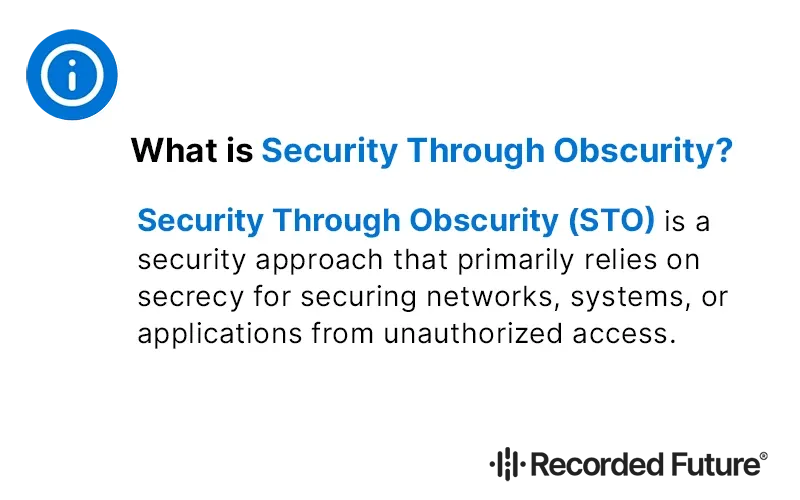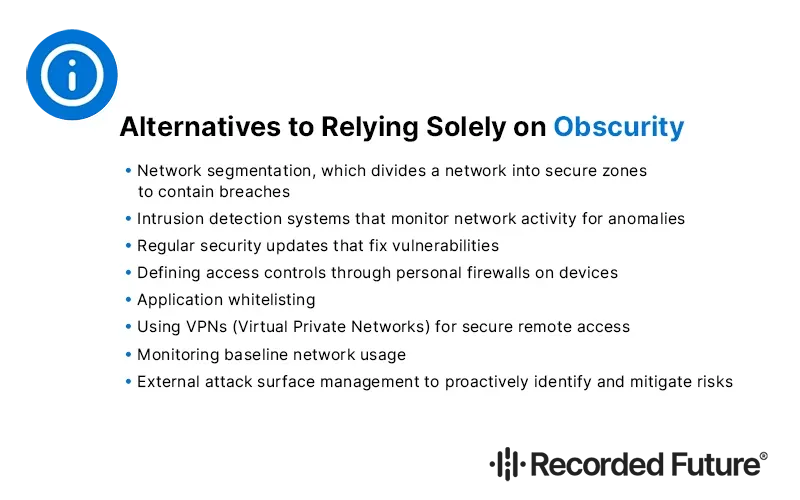Is relying on secrecy an effective way to protect your systems? ‘Security through obscurity’ refers to a contentious practice within cyber defense, where secrecy is the main tool to safeguard systems. While it might mask vulnerabilities temporarily, it raises questions about its effectiveness as a standalone strategy in the face of persistent threats. This article dives into the intricacies of this concept, examining the risks it carries and how it fits into comprehensive security practices.
Key takeaways
- Security Through Obscurity (STO) uses secrecy as a primary method for protecting systems but does not provide direct protective measures against attacks and should not be the sole security strategy.
- While STO can serve as an initial deterrent against basic threats, when used alone it is ineffective against sophisticated attacks and can give a false sense of security. Implementing additional robust security measures such as multi-factor authentication and intrusion detection systems is crucial.
- Employing a comprehensive and layered defense approach, integrating STO with other security tactics, is highly recommended to maintain effective protection in the face of evolving cyber threats and advanced persistent attacks.
What is Security Through Obscurity?
Security Through Obscurity (STO) is a security approach that primarily relies on secrecy for securing networks, systems, or applications from unauthorized access. It’s like a house with hidden doors and secret rooms. Although it can reduce the probability of a system being compromised by making details less visible, it does not provide direct protective measures against attacks.
The concept of STO is not new. It has been around since the 19th century, as evidenced by discussions around Kerckhoffs’ doctrine which emphasized a system’s reliance on its key, not on obscurity, for security. However, it’s important to note that while STO might add a layer of complexity for attackers, relying solely on it falls into the trap of security theater. This practice can lead to a false sense of security, where stakeholders believe their systems are secure simply because they are obscure, not because they have implemented robust security measures. Thus, STO should not be the only security method employed, as it does not ensure actual security against determined adversaries.

The illusion of safety: pros and cons of STO
STO’s hidden doors and secret rooms might appear secure, but they can merely create a safety illusion. The complex nature of today’s IT environments and the increasing number of knowledgeable attackers capable of guessing withheld information undermine the effectiveness of STO.
Hidden but not secure
On the bright side, the obscurity can deter casual cybercriminals, making it less likely for attackers to find and breach hidden information or resources. However, obscurity should not be confused with actual security. If obscurity leads organizations to neglect implementing more effective and robust security measures, it can be counterproductive.
It’s akin to hiding a key under the doormat. It may deter a casual passerby, but a dedicated thief will likely check the mat. Thus, STO isn’t inherently detrimental and can enhance security when complemented with other measures, but it shouldn’t be the only security strategy.
To illustrate this concept, let’s refer to the words to Bruce Schneider: “Obscurity is the idea that when information is hard to obtain or understand, it is, to some degree, safe. Safety, here, doesn’t mean inaccessible.”
The gamble of secrecy: Why STO fails
Dependence on STO as the only line of defense equates to risking your system’s security. It’s an outdated and discouraged practice as it’s impossible to keep all details of a network secret indefinitely, and it contradicts the Zero Trust model best practices.
The secrets that underpin obscurity can inadvertently become public knowledge due to leaks, reverse-engineering, or social engineering, thereby compromising the entire security premise. This can lead to risky security practices such as exposed login panels or shareable links, which fail spectacularly once the secret is revealed, making access to protected data trivial for those with advanced knowledge.
The US Department of Defense clearly states: “Hiding source code does inhibit the ability of third parties to respond to vulnerabilities (because changing software is more difficult without the source code), but this is obviously not a security advantage.”
Layered defense: Integrating STO with robust security measures
Despite its limitations, STO, when combined with robust security measures, can add an extra layer in a comprehensive defense strategy, akin to a castle’s various defensive barriers.
The necessity of multiple security layers
In the realm of cybersecurity, a layered security strategy is vital to establish depth in defense and maintain resilience through various lines of defense. A comprehensive cybersecurity strategy should include layers of security across:
- Systems, with the help of systems engineers
- Networks
- Applications
- Data transmissions
Security through obscurity can complement other crucial layers of security, according to NIST’s recommendation for a resilient and system secure computing environment. However, to maintain protection, it’s necessary to constantly update and audit layered security measures to adapt to emerging threats.
Applying obscurity in system design
Incorporating obscurity in the entire system design resembles constructing architectural camouflage. It can complement other security measures without being the sole line of defense. When properly incorporated, it acts as an extra layer of protection and reduces the probability of a system being compromised.
For instance, systems can apply obscurity by using non-standard service ports, concealing software versions, and employing misleading file names or paths. Remember, the goal is not to rely solely on obscurity, but to use it as a complementary element of a secure computing environment, including a cryptographic system.
Real-life applications: Where does obscurity work?
In practical applications, using obscurity as an extra layer of protection can be effective. For instance, changing the default daemon port on web servers or hiding actual software names and version numbers can provide an extra layer of protection.
Companies like Google employ software developers who use JavaScript obfuscation to protect intellectual property and make their code harder to read, which also reduces file size for efficiency. In the physical realm, deploying decoy cars around a valuable asset can also apply security through obscurity.
The debate within infosec: Expert opinions on STO
The notion of STO has ignited substantial discussions within the infosec community. While some experts advocate for STO when combined with other measures like IP restrictions, firewalls, and SSH port configurations, there is a consensus that STO alone is insufficient for comprehensive security.
The application of STO is considered more appropriate for certain types of systems. However, each case should be assessed for STO’s potential to reduce the probability of an attack or its impact. A widely held view is that STO is not inherently flawed, but its limitations arise from its implementation, especially if not supplemented with a multi-layered security strategy.
Interestingly, government agencies’ backing of STO, such as the NHTSA’s support for keeping vehicle telematics systems closed, has sparked a debate over cybersecurity approaches, highlighting a differing perspective from public sector entities.
How obscurity stands against modern attacks
Cyber threats evolve alongside the digital landscape. The increasing complexity of IT environments and the advancement of users’ system knowledge significantly reduce the effectiveness of STO as a sole protection method. Sophisticated attackers, such as those behind advanced persistent threats, are not deterred by security through obscurity. They use more complex methods to breach defenses. Over-reliance on obscurity can increase the burden on IT security teams, potentially leading to burnout and a drop in effectiveness for managing cybersecurity risks.
Against modern threats, particularly the need to protect against ransomware, obscurity may only provide a misleading sense of security. Accidental leaks of information (such as credential exposure), along with hackers’ ability to reverse-engineer software, can expose obscured system details, negating the protection it intends to provide.
Alternatives to relying solely on obscurity
If obscurity doesn’t provide a foolproof solution, what other options are there? One is multi-factor authentication, which enhances security by requiring multiple forms of verification beyond just a username and password authentication, such as a physical USB dongle with a unique key.
Other alternatives to enhance network security include:
- Network segmentation, which divides a network into secure zones to contain breaches
- Intrusion detection systems that monitor network activity for anomalies
- Regular security updates that fix vulnerabilities
- Defining access controls through personal firewalls on devices
- Application whitelisting
- Using VPNs (Virtual Private Networks) for secure remote access
- Monitoring baseline network usage
- External attack surface management to proactively identify and mitigate risks
These measures, including disable password authentication and implementing security tools, can help protect your network from unauthorized access and potential security threats by ensuring that only authorized users can gain access, thus enhancing system security.

Frequently Asked Questions
What is the fallacy of security through obscurity?
The fallacy of security through obscurity is the belief that keeping a system's design or implementation secret will provide security. However, this can lead to a false sense of security and ultimately result in an insecure system.
Why security through obscurity is not the answer?
Relying solely on security through obscurity is risky because once the secrets are revealed, the system's security is compromised. It should be combined with other security mechanisms for effective protection.
What are the limitations of STO?
The limitations of STO include the potential for a false sense of safety and the risk of hidden details being exposed with determined efforts. It's important to consider these shortcomings when implementing STO.
What are some real-life applications where obscurity works?
Obscurity can work effectively in real-life applications as an additional layer of protection, such as by changing default daemon ports on web servers or concealing software names and version numbers. This approach helps to enhance security and prevent potential threats.
What are some alternatives to relying solely on obscurity?
Instead of relying solely on obscurity, consider using alternatives like multi-factor authentication, network segmentation, intrusion detection systems, security updates, and access controls to enhance your security. These measures can significantly improve your overall security posture.
Summary
As we’ve seen, Security Through Obscurity is a double-edged sword. When used alone, it can create a false sense of safety and fail to provide robust protection against evolving cyber threats. However, when used as an additional layer of protection in conjunction with other robust security measures, it can deter less sophisticated attackers and reduce the probability of a system being compromised.
The key takeaway is that while obscurity can be a part of your security strategy, it should never be the only strategy. Like a castle’s multiple defensive walls, a multi-layered security approach provides the best defense against the ever-evolving landscape of cyber threats.